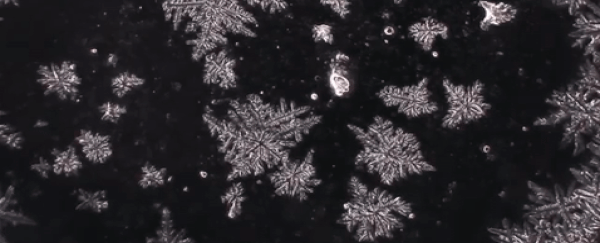Do you know what your tears look like at a microscopic level? Dutch artist Maurice Mikkers does, and he's been looking at hundreds of them. It seems that our tears can be as unique as snowflakes, and have a similar crystallised look under a microscope.
Mikkers was a lab technician before he went to art school, and has yet to find two tears that look alike. He's also investigating how temperature, humidity, and even the cause of the crying can influence a tear's structure.
"[A] dark field microscope will light up the tear on a black background, so you can actually see the beautiful patterns and shapes," Mikkers says in the Quartz video above. "I think tears are so unexplored. We need to figure out why."
There are three main types of tears: basal (or base) tears, that keep our eyes lubricated, reflex tears in response to irritation (like a speck in the eye or onions), and emotional tears (linked to a loss of emotional control, either through happiness or sadness).
Mikkers wants to see how a tear caused by a sad movie could differ in appearance from a tear caused by stubbing your toe. What we do already know is that emotional tears have three extra ingredients: the stress hormones prolactin and adrenocorticotropic hormone, and the painkiller leucine enkephalin.
 A happy tear (left) and a sad tear (right). Credit: Maurice Wikkers
A happy tear (left) and a sad tear (right). Credit: Maurice Wikkers
Of course, when it comes to emotional tears, we all have different trigger levels - the same speech can leave one person a blubbering wreck and have the next yawning. Our personalities could also play into the way our tears look under a microscope.
Mikkers begins by collecting tears into micropipettes. They are then dropped into tubes before being transferred in 1 to 4 mm drops to a microscopic slide. Crystallisation can take between 5 and 30 minutes, depending on the environment.
So far, there's been little research into how our tears crystallise, but Mikkers is determined to keep investigating, creating some unique works of art along the way.
Biomedical scientist Naomi Chayen from the University of London thinks further analytical techniques are going to be required to understand just what makes all of these tears appear so different.
"Crystals are very dependent on the ingredients," she told Kate Groetzinger at Quartz. "If it is the same person and the same day and the emotional tear dries differently than the one caused by the onion, it would be very, very interesting."
Watch the video above to see how Mikkers does it, and see some of the results here and below.
Looking into a fan:
 Maurice Mikkers
Maurice Mikkers
Emotional response:
 Maurice Mikkers
Maurice Mikkers
Eating a hot red pepper:
 Maurice Mikkers
Maurice Mikkers
Cutting white onions:
 Maurice Mikkers
Maurice Mikkers
